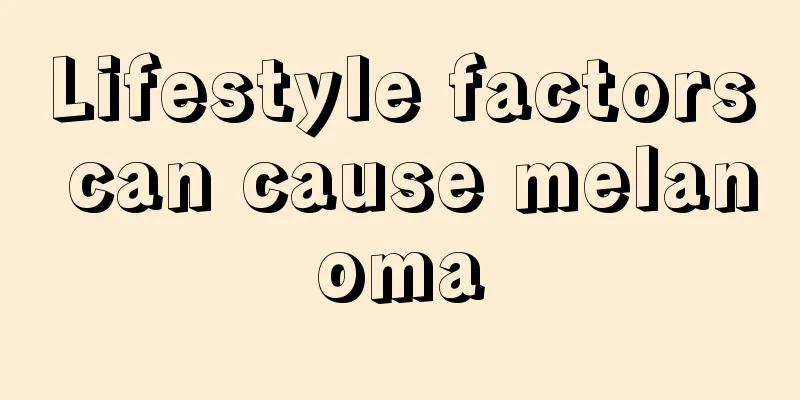Skin disease on waist

|
How to treat vitiligo skin disease on the waist? Vitiligo is a skin disease that is relatively difficult to cure. However, vitiligo cannot be treated without timely treatment. The earlier vitiligo is treated, the better the recovery. Vitiligo can be treated with hormones and epidermal transplantation surgery. Vitiligo is afraid of ultraviolet exposure, so you must take sun protection measures when going out. Skin diseases may occur in various parts of the body. How to treat vitiligo on the waist? Let’s take a look at it next. 1. Vitiligo Speaking of vitiligo, many people know that this disease is a localized or generalized depigmentation spot (white spot) that appears on the face, neck, chest, back, and extremities. Although vitiligo generally does not affect the patient's health, it is unsightly and affects a person's image, which can easily cause psychological burden to the patient. Therefore, many patients with this disease seek medical treatment everywhere, looking for "folk remedies" or cures. As a result, many people fell into the advertising trap of quack doctors, causing them both mental distress and financial loss. In fact, patients with vitiligo should understand that the cause and pathogenesis of vitiligo are still unclear so far, so there is no way to cure the disease. Traditional Chinese medicine believes that vitiligo is caused by the patient's poor emotions, stagnation of liver qi, and wind evil attacking the skin, causing local skin qi stagnation and blood stasis. Modern medicine believes that vitiligo may be a multi-gene hereditary disease. In addition to genetic factors, the occurrence of this disease is also closely related to the patient's own immune factors, destruction of melanocytes, mental factors, chemical factors, endocrine factors, degenerative changes in nerve endings, lack of copper or zinc and other elements, and trauma. So far, although no cure for vitiligo has been found either at home or abroad, it does not mean that there is no way to treat this disease. At present, after years of painstaking research by clinicians, some effective methods for treating vitiligo have been developed. 2. Treatment of vitiligo 1. Autologous epidermal transplantation can be used for treatment: this method uses the principle of negative pressure suction to transplant the patient's own skin epidermis from normal parts to the white spot lesion area to increase the number of melanocytes in the lesion area. During treatment, a porous suction cup (pore diameter of 1.0 cm) made of aluminum, aluminum alloy or plexiglass can be placed on the patient's skin lesions and donor area (the donor area is usually the patient's abdomen and inner thigh). At the same time, appropriate negative pressure (30-60 kPa) is used to attract bubbles and separate the epidermis from the dermis. The foaming process generally takes about 30-90 minutes, and local heating can accelerate the formation of blisters. After blisters appear, first remove the blister epidermis at the affected area. Then remove the blister epidermis from the donor area and transplant it evenly to the lesion, and then apply pressure bandage. After two weeks, the transplanted epidermis will survive and produce obvious pigmentation; after four weeks, the melanin in the transplanted area will deepen and expand; after 3-6 months, the expansion of the pigmentation in the transplanted area can reach its maximum. Autologous epidermal transplantation is a common method with ideal efficacy in treating quiescent localized or segmental vitiligo. Although this method is a surgical treatment, it does not damage the dermis of the skin. Unless the patient has a scar-prone constitution, it generally will not cause scars in the patient and the patient does not need to be hospitalized. At present, many domestic hospitals have launched this therapy, and its success rate is mostly over 90%. 2. It can be treated with photochemotherapy: This method refers to a method in which patients use long-wave ultraviolet rays to treat vitiligo after applying external or oral photosensitizers. The commonly used photosensitizer is 8-methoxypsoralen (8MOP). This therapy has a long course of treatment, and generally patients need 100-300 treatments to achieve the desired effect. However, if there is still no obvious pigmentation in the lesion area after 30 treatments, the patient should stop using this treatment. There are two main ways of using photochemotherapy: ① Medication and irradiation therapy. Generally, 8-methoxypsoralen (8MOP) is taken orally at a dose of 0.3-0.6 mg/kg body weight 1-2 hours before irradiation, and then long-wave ultraviolet irradiation is performed. This method can be used for treatment 2-3 times a week. At the beginning of treatment, the patient can be irradiated for 1-5 minutes each time, and the irradiation time can be gradually extended later. Generally, the irradiation time is determined when a mild erythema or sub-erythema reaction occurs on the skin in the affected area. ② The patient should first apply topically 0.1% 8-methoxypsoralen solution or psoralea corylifolia tincture (the preparation method of psoralea corylifolia tincture is: soak 30 grams of psoralea corylifolia in 100 ml of 75% alcohol for 7-10 days, remove the residue and take the juice to make 30% psoralea corylifolia tincture). Long-wave ultraviolet rays can be used for irradiation 30-60 minutes after taking the medicine. This method can be used for treatment 2-3 times a week, and generally takes about 3 months. This method is more effective for patients with localized or segmental vitiligo. 3. It can be treated with dermabrasion: this method is to use a grinder or sandpaper to scrape the epidermis of the lesion. When slight punctate bleeding appears locally, apply 5% 5-fluorouracil cream, then bandage with gauze and adhesive tape. Change the dressing once a day and the medication can be used continuously for 7-10 days. This treatment method can stimulate the proliferation and differentiation of melanocytes in the skin lesions. Generally, the patient's epidermis can regenerate after one week of treatment, and local pigmentation begins to appear after 2 weeks. According to reports from home and abroad, the cure rate of vitiligo treated with this method is 18.3%-64%, and the effective rate is 83.3%-89.2%. 4. Corticosteroids can be used for treatment: Clinically proven, oral, topical or local injection of corticosteroids have certain effects on vitiligo. At present, the therapeutic mechanism of this method is still unclear, but most people believe that it may be related to the immunosuppressive effect of this type of drug. Commonly used corticosteroids include prednisone, 0.2% betamethasone cream, compound scutellaria baicalensis ointment, scutellaria acetate A suspension and diprosone solution. The specific uses of these drugs are: ① Prednisone: Take orally once at 8 am a day, 0.3 mg per kilogram of body weight. After taking it for 2 consecutive months, the dosage can be halved. After taking it for 4 consecutive months, the dosage can be halved again on the basis of the halved dosage. However, patients should be reminded that if there is no effect after taking the medicine for 4 weeks, this method should be stopped. This treatment method is generally suitable for patients with generalized vitiligo in the progressive stage with larger white spots. Some people abroad used small doses of prednisone to treat 81 patients in the progressive stage for 5 months, and the rates of preventing vitiligo progression and repigmentation were 87.7% and 70.4%, respectively. ②0.2% betamethasone cream or compound sildenafil ointment: You can choose either of these two medicines and apply it to the affected area twice a day. ③ Triamcinolone A suspension or Diprosone solution: Choose one of these two drugs and use a syringe to take 0.5 ml - 1 ml of the solution, mix it with 1 ml of 2% lidocaine, insert the needle outside the edge of the lesion, and inject into the superficial layer of the skin. After injection, the local appearance may appear as orange peel-like raised areas. Generally, the injection is given once every 1-2 weeks, and a course of treatment is 10 days. If the patient needs repeated treatment, the interval between treatments should be 4 weeks. Since children with vitiligo are more responsive to hormonal drug treatment, this method can be used as the first choice treatment for children with vitiligo. However, patients should be reminded that long-term use of hormone drugs can cause adverse reactions such as capillary dilation, menstrual disorders, weight gain, folliculitis, pigmentation, skin atrophy, etc. Therefore, such drugs should be used under the guidance of a doctor. 5. Available depigmentation therapy: When the patient's skin lesions are larger than 50% of the body surface area, or only a small area of normal skin color remains on the face, and other treatments are ineffective, depigmentation therapy can be considered. The specific operation method is: apply 10%-20% hydroquinone monophenyl ether ointment or 4-p-methoxyphenol to the skin lesions twice a day. Because the area of the lesions is large, they can be gradually depigmented during treatment. A common adverse reaction to this therapy is local contact dermatitis. 6. Available immunotherapy drugs: immunotherapy drugs have the function of transmitting immune information and regulating immune balance. Commonly used drugs of this type include transfer factor, levamisole, etc. The specific usage of this type of drug in the treatment of vitiligo is: when using transfer factor, 1-2 units are used each time, which can be injected intramuscularly. Inject once every 1-2 weeks. When using levamisole, you can take it for 2 consecutive days a week, once a day, 150 mg each time. The use of transfer factor may cause patients to experience adverse reactions such as skin itching and fever. Long-term intramuscular injection of transfer factor may also produce adverse reactions such as focal muscle necrosis. This should be brought to the attention of patients. 7. Traditional Chinese medicine can be used for treatment: Studies have shown that traditional Chinese medicine is effective in treating vitiligo and has fewer side effects. Among them, the inhibition rate of tyrosinase activity of five Chinese herbal medicines, including black plum, cinnamon bark, vitex rotundifolia, cornus officinalis, and prunella vulgaris, can reach 100%. The inhibition rates of Chinese medicine Pulsatilla, Aconitum, Coptis chinensis, Leonurus japonicus and Gleditsia sinensis on tyrosine activity were 80.4%, 66.0%, 62.0%, 54.9% and 52.9% respectively. In addition, Chinese medicines such as Tribulus terrestris, Psoralea corylifolia, Angelica dahurica, fig leaves and Angelica pubescens all have photosensitizing effects, which can activate melanocytes and promote pigment formation. Chinese medicines such as Polygonum multiflorum, Poria cocos, Lithospermum officinale, Tribulus terrestris, Eclipta prostrata, Angelica sinensis, Safflower and Astragalus membranaceus all have the effects of soothing the liver and regulating qi, promoting blood circulation and dispelling wind, and have certain therapeutic effects on vitiligo. Traditional Chinese medicine often adopts the principle of syndrome differentiation and treatment in the treatment of vitiligo. The Chinese patent medicines commonly used in clinical practice include Baibo Pills, Xiaoban Pills, Baishi Pills, Bailing Tablets, Vitiligo Pills, Vitiligo Granules, Baidian Pills, Psoralea Injection and Zhiban Injection. The usage of Psoralea corylifolia injection and Zhiban injection is: 2 ml each time intramuscular injection, once a day, and a course of treatment is 30 days. Other scholars have used more than 10 kinds of Chinese medicine to formulate a prescription, including 12 grams each of Angelica sinensis, Chuanxiong, Red Peony Root, Astragalus, Processed Polygonum multiflorum, White Moss Bark, and Saposhnikovia divaricata (the medicines in the prescription can be added or subtracted according to the symptoms), and took the decoction, one dose per day, divided into three times, and 30 days as a course of treatment. While taking this medicine, you should also apply Xiaobai tincture to the skin lesions twice a day. (The preparation method of Xiaobai Tincture is: take 30 grams of Psoralea corylifolia, 10 grams of Angelica dahurica, and 10 grams of cinnamon. Soak the above medicines in 100 ml of 70% alcohol for 7 days, then filter out the liquid medicine, then soak the residue in 100 ml of 70% alcohol for 7 days and then filter out the liquid medicine. Combine the two filtered liquid medicines). The total effectiveness of this treatment method for localized, sporadic and segmental vitiligo is over 80%. In addition to Xiaobai tincture, other Chinese medicines for external use include Psoralea corylifolia tincture and Wumei tincture (the preparation method of Wumei tincture is: put 10 grams of black plums in 100 ml of 75% alcohol, soak for 7 days, and then filter out the medicinal liquid). 3. What should patients with vitiligo pay attention to when treating the disease? 1. Keep a good mood and avoid adverse factors such as mental trauma, sadness, impatience, overwork, and excessive worry that may affect the efficacy of the treatment. 2. Since vitamin C can participate in the metabolism of tyrosinase in the body and has the effect of inhibiting pigment production, patients should try to avoid consuming foods rich in vitamin C during treatment, such as grapefruit, orange, tangerine, tomato, sour jujube, kiwi and bell pepper, etc. Instead, they should eat more foods rich in tyrosine and copper, zinc, iron and other substances, such as lean meat, eggs, various animal offal, milk, eggplant, loofah, carrots and soy products, etc., to promote the production of skin melanin. 3. Avoid using drugs or cosmetics that inhibit tyrosinase activity, such as hydroquinone (hydroquinone), azelaic acid, whitening agents, hair dyes, and antiseptic cleansers containing phenols and catechols. 4. As the disease progresses, patients should avoid excessive sun exposure and avoid using irritating medications to avoid aggravating the condition. 5. Since the non-surgical treatment of this disease generally requires more than 3 months to achieve better results, patients cannot give up halfway when treating the disease. However, if the condition does not improve after using a treatment for 2 months, the patient may consider switching to a new treatment. When a single therapy is ineffective, patients can also use 2-3 or more methods for combined treatment. |
<<: Can applying yogurt on the face remove acne?
Recommend
What should patients with advanced liver cancer eat? Dietary considerations for advanced liver cancer
Many people are not very clear about some conditi...
How to remove nail polish
Nail polish is one of every girl's favorite i...
Diagnosis basis of appendicitis
Once people suffer from appendicitis, they will e...
How to prevent hepatitis from turning into liver cancer? Eight tips to prevent hepatitis from turning into liver cancer
"Hepatitis - cirrhosis - liver cancer" ...
How to wash off engine oil stains
In daily life, we always face some troubles, and ...
Meridians of the human body
The meridians are spread all over the body and pl...
How does the pathology of nasopharyngeal carcinoma change
In recent years, nasopharyngeal carcinoma has bec...
Diagnostic methods for early cervical cancer
If cervical cancer is discovered early, it will b...
What is the reason for the hot instep
In winter, people always feel extreme cold and he...
How to treat mild hypertension, 3 methods to help you
Hypertension is a common disease that is related ...
What are the functions of combing hair
Everyone knows that the human head is home to man...
What are the causes of lung cancer? Knowing these causes of lung cancer can effectively prevent it
We must understand the causes of lung cancer, but...
Why are my hands numb?
People who often experience numbness and weakness...
What are the early symptoms of thyroid cancer
Most patients with thyroid cancer have no obvious...
Nutritional recipes for junior high school students
For students who are in school, they must have ad...









